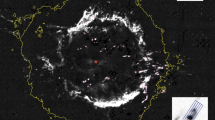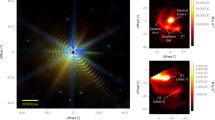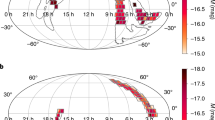Abstract
Be STARS are rapidly rotating, non-supergiant B stars showing hydrogen-line emission and characterized by an excess of continuum emission from near-infrared to radio wavelengths. The latter is thought to arise from thermal bremsstrahlung in hot circumstellar gas1, for which both spherical and disk-like geometries have been proposed2,3 to explain observations at different wavelengths. The first Be star to be detected at radio wavelengths was the B5 giant ΨPersei4–6, which is the brightest radio-emitting Be star. Using the Very Large Array, we have resolved the circumstellar envelope of Ψ Per at 15 GHz, and find that the radio emission comes from a non-spherical distribution of thermally radiating gas. The radio-emitting region has a major axis of 111 ±16 mas (17 AU at a distance of 155 pc), and is unresolved, with a 3σ upper limit of 68 mas, along its minor axis. Our observations confirm the proposal, due to Struve in 1931 (ref. 5), of equatorially enhanced circumstellar plasma distributions as the source of Be star emission.
This is a preview of subscription content, access via your institution
Access options
Subscribe to this journal
Receive 51 print issues and online access
$199.00 per year
only $3.90 per issue
Buy this article
- Purchase on SpringerLink
- Instant access to full article PDF
Prices may be subject to local taxes which are calculated during checkout
Similar content being viewed by others
References
Waters, L. B. F. M., van der Veen, W. E. C. J., Taylor, A. R., Marlborough, J. M. & Dougherty, S. M. Astr. Astrophys. 244, 120–130 (1990).
Marlborough, J. M. in Physics of Be stars (eds Slettebuk, A. & Snow, T. P.) 316–338 (Cambridge Univ. Press, 1987).
Doazon, V. in Physics of Be stars (eds Slettebak, A. & Snow, T. P.) 384–403 (Cambridge Univ. Press, 1987).
Taylor, A. R., Waters, L. B. F. M., Lamers, H. G. L. M., Persi, P. & Bjorkman, K. S. Mon. Not. R. astr. Soc. 288, 811–817 (1987).
Taylor, A. R., Waters, L. B. F. M., Bjorkman, K. S. & Dougherty, S. M. Astr. Astrophys. 231, 453–458 (1990).
Dougherty, S. M., Taylor, A. R. & Waters, L. B. F. M. Astr. Astrophys. 248, 175–178 (1991).
Struve, O. Astrophys. J. 73, 94–103 (1931).
Snow, T. P. in Physics of Be stars (eds Slettebak. A. & Snow, T. P.) 250–260 (Cambridge Univ. Press, 1987).
Marlborough, J. M. & Cowley, A. P. Astrophys. J. 187, 99–105 (1974).
Oegerle, W. R. & Polidan, R. S. Astrophys. J. 285, 648–655 (1984).
Slettebak, A. Astrophys. J. Suppl. 50, 55–84 (1982).
Poeckert, R. & Marlborough, J. M. Astrophys. J. 206, 182–195 (1976).
McLean, I. S. & Brown, J. D. Astr. Astrophys. 69, 291–296 (1978).
Poeckert, R., Bastien, P. & Landstreet, J. D. Astr. J. 84, 812–830 (1979).
Peters, G. J. in Be Stars, IAU Colloq. No. 98 (eds Jaschek, M. & Groth, H.) 353–356 (Reidel, Dordrecht, 1982).
Waters, L. B. F. M. Astr. Astrophys. 162, 121–139 (1986).
Slettebak, A. in Physics of Be stars (eds Slettebak, A. & Snow, T. P.) 24–35 (Cambridge Univ. Press. 1987).
Author information
Authors and Affiliations
Rights and permissions
About this article
Cite this article
Dougherty, S., Taylor, A. Resolution of the circumstellar gas around the Be star Ψ Persei. Nature 359, 808–810 (1992). https://doi.org/10.1038/359808a0
Received:
Accepted:
Issue Date:
DOI: https://doi.org/10.1038/359808a0
Comments
By submitting a comment you agree to abide by our Terms and Community Guidelines. If you find something abusive or that does not comply with our terms or guidelines please flag it as inappropriate.



